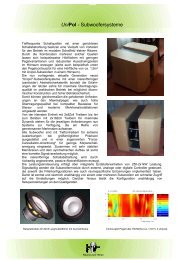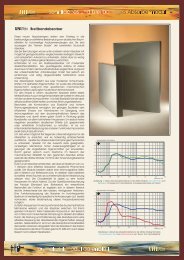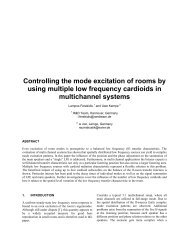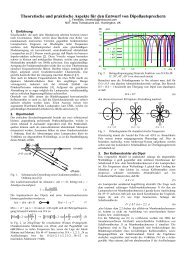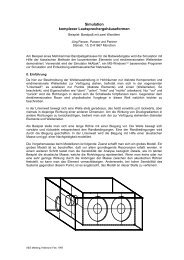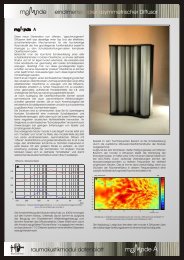the beneficial coupling of cardioid low frequency sources to ... - W Vier
the beneficial coupling of cardioid low frequency sources to ... - W Vier
the beneficial coupling of cardioid low frequency sources to ... - W Vier
Create successful ePaper yourself
Turn your PDF publications into a flip-book with our unique Google optimized e-Paper software.
Proceedings <strong>of</strong> <strong>the</strong> Institute <strong>of</strong> Acoustics<br />
THE BENEFICIAL COUPLING OF CARDIOID LOW<br />
FREQUENCY SOURCES TO THE ACOUSTICS OF SMALL<br />
ROOMS<br />
L Ferekidis, wvier, Lemgo, Germany<br />
Email: l.ferekidis@wvier.de<br />
1 INTRODUCTION<br />
Since <strong>the</strong> early days <strong>of</strong> high fidelity, <strong>the</strong> reproduction <strong>of</strong> <strong>low</strong> frequencies has always been an area<br />
that attracted researcher’s interested. Apart from <strong>the</strong> sheer joy <strong>the</strong> physical impact <strong>of</strong> proper <strong>low</strong><br />
<strong>frequency</strong> reproduction can deliver, <strong>low</strong> frequencies form <strong>the</strong> foundation upon which music is built.<br />
They also contain sonic clues that carry information about <strong>the</strong> acoustical size <strong>of</strong> <strong>the</strong> recording<br />
venue.<br />
The reproduction <strong>of</strong> <strong>low</strong> frequencies in listening rooms, studios, or home cinemas depends not only<br />
on <strong>the</strong> loudspeaker used but also on <strong>the</strong> acoustic conditions <strong>of</strong> <strong>the</strong> room itself. Due <strong>to</strong> <strong>the</strong> <strong>low</strong><br />
density <strong>of</strong> room modes in this <strong>frequency</strong> range, <strong>the</strong> sonic reproduction quality is strongly determined<br />
by <strong>the</strong> mode’s distribution in <strong>frequency</strong> and <strong>the</strong>ir damping. A change <strong>of</strong> ei<strong>the</strong>r <strong>the</strong> damping or <strong>the</strong><br />
modal distribution usually requires substantial structural measures. Since in most circumstances<br />
one or <strong>the</strong> o<strong>the</strong>r parameter cannot be changed, <strong>the</strong> LF-source itself (and here in particular its<br />
radiation characteristic) and its position in <strong>the</strong> room remain <strong>the</strong> only variables open <strong>to</strong> changes.<br />
The target is an even <strong>frequency</strong> response in <strong>the</strong> preferred listening area. This requires an even<br />
excitation <strong>of</strong> all a room modes, provided <strong>the</strong>y are evenly distributed. The excitation <strong>of</strong> a mode<br />
depends on <strong>the</strong> LF-source’s position in <strong>the</strong> room and its transducer characteristic. Besides <strong>the</strong><br />
modal <strong>coupling</strong> <strong>of</strong> loudspeaker and listener, specular reflections, or so-called image <strong>sources</strong>, also<br />
affect <strong>the</strong> LF-transfer function.<br />
2 Theoretical considerations<br />
The fol<strong>low</strong>ing section is taken from Olson [1], since it represents a comprehensive overview <strong>of</strong> <strong>the</strong><br />
different kinds <strong>of</strong> gradient <strong>sources</strong>. Of particular interest are <strong>the</strong> bi- and unidirectional first order<br />
gradient sound <strong>sources</strong>, while <strong>the</strong> zero-order gradient sound source (omnidirectional source) is<br />
included only for reasons <strong>of</strong> completeness. For each source type <strong>the</strong> ma<strong>the</strong>matical description <strong>of</strong><br />
<strong>the</strong> on-axis transfer-function and <strong>the</strong> radiation characteristic is introduced and visualised.<br />
2.1 Omnidirectional source (monopole)<br />
The omnidirectional source consists <strong>of</strong> a single point source radiating sound in all directions with<br />
equal amplitude. The normalised transfer function |H(ω)| and <strong>the</strong> polar directivity pattern |R(T )| are<br />
given in Fig. 1. This source is later used <strong>to</strong> create <strong>the</strong> two first order gradient <strong>sources</strong>.<br />
The omnidirectional polar directivity pattern makes <strong>the</strong> monopole a pressure source. As such it<br />
imprints a pressure change on all air particles surrounding <strong>the</strong> source.<br />
Vol.25. Pt.8.2003
T<br />
Proceedings <strong>of</strong> <strong>the</strong> Institute <strong>of</strong> Acoustics<br />
Vol.25. Pt.8.2003<br />
dB<br />
10<br />
0<br />
-10<br />
-20<br />
-30<br />
-40<br />
Level<br />
0.1 0.3 0.5 1 3 D/λ 5<br />
Fig. 1 Schematic, normalised <strong>frequency</strong> response |H(ω)|, and polar directivity pattern |R(T )| <strong>of</strong> an omnidirectional source.<br />
2.2 Bidirectional source (dipole)<br />
A bidirectional source (or dipole) is constituted by two omnidirectional point <strong>sources</strong> spaced at a<br />
distance D and operating with 180° phase difference. The line connecting <strong>the</strong> two point <strong>sources</strong> is<br />
referred <strong>to</strong> as <strong>the</strong> dipole-axis. The normalised transfer function |H(D/λ)| and <strong>the</strong> polar directivity<br />
pattern |R(T )| are described in formula (1) and (2), while <strong>the</strong> corresponding functions are shown in<br />
Fig. 2.<br />
D<br />
dipole axis<br />
T<br />
dB<br />
10<br />
+6<br />
0<br />
-10<br />
-20<br />
-30<br />
-40<br />
R(T )<br />
180°<br />
|H(D/λ)|<br />
H<br />
2<br />
⎛<br />
⎜<br />
⎝<br />
D<br />
λ<br />
⎞<br />
⎟<br />
⎠<br />
⎛ D ⎞<br />
R(<br />
θ ) = sin⎜π<br />
⋅ cos( θ ) ⎟<br />
⎝ λ ⎠<br />
( D λ)<br />
= ⋅ sin π ⋅ cos( θ ) ( 1)<br />
( 2)<br />
0.1 0.3 0.5 1 3 D/λ 5<br />
90°<br />
0° 180°<br />
90°<br />
0° 180°<br />
270°<br />
270°<br />
270°<br />
D/λ = 0.5 D/λ = 1.0 D/λ = 1.5<br />
Fig. 2 Schematic, normalised <strong>frequency</strong> response |H(D/λ)| for T = 0, and polar directivity pattern |R(T )| <strong>of</strong> a bidirectional<br />
source.<br />
Typical dipole characteristics comprise a 6dB/oct. decay for frequencies D/λ < 0.5 and locale<br />
minima <strong>of</strong> |H(D/λ)| at D/λ = 1,2,3,…N. The depicted polar plots show clearly that for frequencies D/λ<br />
> 0.5 <strong>the</strong> dipole develops a multi-polar radiation characteristic with <strong>the</strong> number <strong>of</strong> lobes increasing<br />
by 4D/λ. The polar directivity for frequencies D/λ < 0.25 is a dipole, while <strong>the</strong> bidirectional operating<br />
range is restricted <strong>to</strong> frequencies D/λ < 0.7. Increasing <strong>the</strong> distance D between <strong>the</strong> two point<br />
<strong>sources</strong> <strong>low</strong>ers both, <strong>the</strong> <strong>low</strong>er as well as <strong>the</strong> upper limit <strong>of</strong> <strong>the</strong> bidirectional operating range.<br />
The ideal dipole is infinitesimally small and acts as a gradient source. As such it imprints a velocity<br />
change on <strong>the</strong> surrounding air particles along <strong>the</strong> dipole axis, thus it is a directional dimension.<br />
180°<br />
90°<br />
270°<br />
0°<br />
90°<br />
0°
Proceedings <strong>of</strong> <strong>the</strong> Institute <strong>of</strong> Acoustics<br />
2.3 Unidirectional source (<strong>cardioid</strong>)<br />
A unidirectional radiation characteristic is achieved by time-delaying one <strong>of</strong> <strong>the</strong> two point <strong>sources</strong> in<br />
Fig. 2. The <strong>cardioid</strong>-axis is <strong>the</strong> connecting line between <strong>the</strong> two point <strong>sources</strong>. If <strong>the</strong> time-delay is<br />
equivalent <strong>to</strong> <strong>the</strong> travel distance between <strong>the</strong> two point <strong>sources</strong>, <strong>the</strong> unidirectional pattern becomes<br />
a <strong>cardioid</strong>. The transfer function and directivity pattern for a <strong>cardioid</strong> are shown in Fig. 3 <strong>to</strong>ge<strong>the</strong>r<br />
with <strong>the</strong> analytical description.<br />
D/2<br />
<strong>cardioid</strong> axis<br />
D/2<br />
Vol.25. Pt.8.2003<br />
dB<br />
10<br />
+6<br />
0<br />
-10<br />
-20<br />
-30<br />
-40<br />
180°<br />
|H(D/λ)|<br />
H<br />
2<br />
⎛<br />
⎜<br />
⎝<br />
D<br />
2λ<br />
⎞<br />
⎟<br />
⎠<br />
⎛ D<br />
⎞<br />
R(<br />
θ ) = sin⎜π<br />
⋅ ( 1+<br />
cos( θ )) ⎟<br />
⎝ 2λ<br />
⎠<br />
( D λ)<br />
= ⋅ sin π ⋅ ( 1 + cos( θ )) ( 3)<br />
( 4)<br />
0.1 0.3 0.5 1 3 D/λ 5<br />
R(T )<br />
90°<br />
0° 180°<br />
90°<br />
0° 180°<br />
270°<br />
270°<br />
270°<br />
D/λ = 0.5 D/λ = 1.0 D/λ = 1.5<br />
Fig. 3 Schematic, normalised <strong>frequency</strong> response |H(D/λ)| for T = 0, and polar directivity pattern |R(T )| <strong>of</strong> a<br />
unidirectional source.<br />
Being a derivative <strong>of</strong> <strong>the</strong> dipole, <strong>the</strong> <strong>cardioid</strong> shares <strong>the</strong> 6dB/oct. slope for frequencies D/λ < 0.5 and<br />
<strong>the</strong> locale (on-axis) minima <strong>of</strong> |H(D/λ)| for D/λ = 1,2,3,…N. The polar directivity for D/λ < 0.25 is a<br />
<strong>cardioid</strong>, but sustains a unidirectional shape up <strong>to</strong> D/λ < 0.7.<br />
The <strong>cardioid</strong> originates from <strong>the</strong> superposition <strong>of</strong> a monopole and a dipole. Consequently it unites<br />
both pressure source and gradient source. A measure for <strong>the</strong> gradient component is <strong>the</strong> front-<strong>to</strong>back<br />
level ratio, where large values indicate a strong gradient component.<br />
3 Basic room acoustic<br />
T<br />
In <strong>the</strong> previous section, ma<strong>the</strong>matical descriptions are given for <strong>the</strong> three <strong>sources</strong> compared. The<br />
results are derived for <strong>the</strong> source radiating in<strong>to</strong> a free space. In practise, loudspeakers are not used<br />
in free space but are placed in a room <strong>of</strong>ten closed <strong>to</strong> adjacent boundaries such as walls. In this<br />
section <strong>the</strong> impact <strong>of</strong> <strong>the</strong> room on <strong>the</strong> loudspeaker-listener-transfer-function is investigated. In<br />
particular two effects, <strong>the</strong> excitation <strong>of</strong> room modes and <strong>the</strong> interaction with adjacent boundaries,<br />
are examined. Using two simplified models <strong>the</strong> way <strong>the</strong> loudspeaker-listener link is affected is<br />
explained for each source individually.<br />
90°<br />
0°
Proceedings <strong>of</strong> <strong>the</strong> Institute <strong>of</strong> Acoustics<br />
dB Level Level dB<br />
100 35<br />
90 25<br />
80 15<br />
70 5<br />
60 -5<br />
50 -15<br />
20 50 100 200 500<br />
Hz<br />
Fig. 4 On-axis <strong>frequency</strong> response <strong>of</strong> a monopole in free-field (⎯ black) and with a specular reflection at w = 0.2m<br />
(⎯ blue), w = 0.5m (--- green), and w = 1.0m (-.- red). Lower three traces are normalised <strong>to</strong> free-field-response.<br />
dB Level Level dB<br />
100 35<br />
90 25<br />
80 15<br />
70 5<br />
60 -5<br />
20 50 100 200 500<br />
Hz<br />
Fig. 5 On-axis <strong>frequency</strong> response <strong>of</strong> a dipole in free-field (⎯ black) and with a specular reflection at w = 0.2m (⎯ blue),<br />
w = 0.5m (--- green), and w = 1.0m (-.- red). Lower three traces are normalised <strong>to</strong> free-field-response.<br />
dB Level Level dB<br />
100 35<br />
90 25<br />
80 15<br />
70 5<br />
60 -5<br />
50 -15<br />
20 50 100 200 500<br />
Hz<br />
Fig. 6 On-axis <strong>frequency</strong> response <strong>of</strong> a <strong>cardioid</strong> in free-field (⎯ black) and with a specular reflection at w = 0.2m<br />
(⎯ blue), w = 0.5m (--- green), and w = 1.0m (-.- red). Lower three traces are normalised <strong>to</strong> free-field-response.<br />
Vol.25. Pt.8.2003<br />
l<br />
w<br />
l<br />
w<br />
l<br />
w
Proceedings <strong>of</strong> <strong>the</strong> Institute <strong>of</strong> Acoustics<br />
3.1 Reflection on a single boundary<br />
When a loudspeaker is placed near a solid boundary, some waves, which would o<strong>the</strong>rwise radiate<br />
away from <strong>the</strong> listener, are reflected <strong>to</strong>wards him. The listener perceives <strong>the</strong> superposition <strong>of</strong> <strong>the</strong><br />
direct-radiated and <strong>the</strong> reflected wave.<br />
This scenario has been simulated using <strong>the</strong> simulation s<strong>of</strong>tware AkAbak. The results for each<br />
source type are presented in Fig. 4, Fig. 5, and Fig. 6. The distance between listener and source is<br />
kept constant at l = 2m. The four traces in <strong>the</strong> upper half <strong>of</strong> each diagram represent <strong>the</strong> simulated<br />
on-axis <strong>frequency</strong> response (black) under free-field conditions and with a reflective boundary<br />
introduced. The impact <strong>of</strong> <strong>the</strong> distance w between <strong>the</strong> source and <strong>the</strong> boundary on <strong>the</strong> <strong>frequency</strong><br />
response is shown for w = 0.2m, 0.5, 1.0m. The <strong>low</strong>er three curves in each diagram show <strong>the</strong> level<br />
difference between <strong>the</strong> reflective-boundary- and <strong>the</strong> free-field-condition.<br />
In <strong>the</strong> <strong>frequency</strong> range <strong>of</strong> interest (f
Proceedings <strong>of</strong> <strong>the</strong> Institute <strong>of</strong> Acoustics<br />
Fig. 7 Pressure distribution <strong>of</strong> <strong>the</strong> first order mode between two walls, separated by a distance L. Positions for maximum<br />
mode excitation <strong>of</strong> monopole, dipole, and <strong>cardioid</strong>.<br />
The one-dimensional model in Fig. 7 has one important limitation that should not be overlooked.<br />
Real rooms are three-dimensional, thus <strong>the</strong> <strong>cardioid</strong>’s position-independent <strong>coupling</strong> <strong>to</strong> a mode<br />
would disappears for all axial modes propagating in <strong>the</strong> o<strong>the</strong>r two directions. Turning <strong>the</strong> <strong>cardioid</strong>axis<br />
<strong>to</strong> an angle such that its velocity-component couples in<strong>to</strong> x-, y-, and z-direction can fix this<br />
problem.<br />
4 Experimental results<br />
In this section <strong>the</strong> mode-<strong>coupling</strong> properties <strong>of</strong> <strong>the</strong> three described <strong>sources</strong> are verified on <strong>the</strong> basis<br />
<strong>of</strong> measurements taken in a 4.0x5.0x2.6m sized reverberation chamber. The transfer functions<br />
were measured for three positions A, B, and C as depicted in Fig. 8. The <strong>low</strong> damping environment<br />
<strong>of</strong> <strong>the</strong> rev-chamber was chosen, because it emphasises <strong>the</strong> differences in mode excitation.<br />
Vol.25. Pt.8.2003<br />
4.95 m C<br />
y<br />
A<br />
4.14 m H = 2.62 m<br />
B 4.23 m<br />
3.04 m<br />
Fig. 8 Dimensions <strong>of</strong> <strong>the</strong> reverberation chamber and measurement positions A, B, and C.<br />
The acquired excitation patterns are judged using <strong>the</strong> first order axial modes in x- (100-mode @<br />
38Hz) and y-direction (010-mode @ 46Hz). Type, position and orientation (dipole & <strong>cardioid</strong>) <strong>of</strong> <strong>the</strong><br />
<strong>sources</strong> fol<strong>low</strong> from <strong>the</strong> sketches <strong>to</strong> <strong>the</strong> left <strong>of</strong> each diagram. The microphone was placed in <strong>the</strong><br />
<strong>low</strong>er left corner <strong>of</strong> <strong>the</strong> reverberation chamber. All impulse responses were acquired at 5kHz<br />
sampling rate with a <strong>to</strong>tal duration <strong>of</strong> 1.2 sec. Individual equalisation was applied <strong>to</strong> each <strong>sources</strong> <strong>to</strong><br />
assure identical on-axis responses under free-field conditions.<br />
4.1 Position and orientation<br />
In Fig. 9 <strong>the</strong> responses are plotted for corner placement with diagonal orientation <strong>of</strong> <strong>the</strong> two gradient<br />
<strong>sources</strong>. As expected <strong>the</strong> monopole (---) shows good excitation <strong>of</strong> both modes, as does <strong>the</strong> <strong>cardioid</strong><br />
(⎯), while <strong>the</strong> dipole suffers from a broad cancellation due <strong>to</strong> <strong>the</strong> three adjacent boundaries.<br />
Mic<br />
x
Proceedings <strong>of</strong> <strong>the</strong> Institute <strong>of</strong> Acoustics<br />
A<br />
100<br />
Vol.25. Pt.8.2003<br />
010<br />
dB<br />
0<br />
-10<br />
-20<br />
-30<br />
-40<br />
Level<br />
100 010<br />
-50<br />
20 50 100<br />
Fig. 9 Room transfer function <strong>of</strong> monopole (blue ---), dipole (red -.-), and <strong>cardioid</strong> (green ⎯) at position A with diagonal<br />
orientation.<br />
In Fig. 10 <strong>the</strong> <strong>sources</strong> are positioned at <strong>the</strong> centre <strong>of</strong> <strong>the</strong> rev-chamber while <strong>the</strong> diagonal orientation<br />
is maintained. Again <strong>the</strong> <strong>cardioid</strong> shows <strong>the</strong> best <strong>coupling</strong> <strong>of</strong> all three <strong>sources</strong>, fol<strong>low</strong>ed by <strong>the</strong><br />
dipole, because <strong>of</strong> its good <strong>coupling</strong> <strong>to</strong> <strong>the</strong> local pressure-node. The monopole shows poor <strong>coupling</strong><br />
<strong>to</strong> both modes.<br />
100<br />
B<br />
010<br />
dB<br />
0<br />
-10<br />
-20<br />
-30<br />
-40<br />
Level<br />
100 010<br />
-50<br />
20 50 100<br />
Fig. 10 Room transfer function <strong>of</strong> monopole (blue ---), dipole (red -.-), and <strong>cardioid</strong> (green ⎯) at position B with diagonal<br />
orientation.<br />
The <strong>cardioid</strong>’s excitation pattern is not affected by moving <strong>the</strong> <strong>sources</strong> in position C, half way along<br />
<strong>the</strong> length <strong>of</strong> <strong>the</strong> chamber. The strong excitation it achieved in position B (Fig. 10) is sustained. The<br />
monopole shows good <strong>coupling</strong> <strong>to</strong> <strong>the</strong> 010-mode but fails <strong>to</strong> excite <strong>the</strong> 100-mode since it is placed<br />
in its pressure-node. Unsurprisingly, <strong>the</strong> dipole shows <strong>the</strong> opposite behaviour.<br />
Hz<br />
Hz
Proceedings <strong>of</strong> <strong>the</strong> Institute <strong>of</strong> Acoustics<br />
100<br />
C<br />
Vol.25. Pt.8.2003<br />
010<br />
dB<br />
0<br />
-10<br />
-20<br />
-30<br />
-40<br />
Level<br />
100 010<br />
-50<br />
20 50 100<br />
Fig. 11 Room transfer function <strong>of</strong> monopole (blue ---), dipole (red -.-), and <strong>cardioid</strong> (green ⎯) at position C with diagonal<br />
orientation.<br />
Finally <strong>the</strong> two gradient <strong>sources</strong> are orientated along <strong>the</strong> width <strong>of</strong> <strong>the</strong> reverberation chamber (y-axis,<br />
Fig. 12). Both show only weak <strong>coupling</strong> <strong>to</strong> <strong>the</strong> 100-mode. While <strong>the</strong> <strong>cardioid</strong> actively suppresses <strong>the</strong><br />
100-mode by pushing energy in<strong>to</strong> both ends, <strong>the</strong> dipole just fails <strong>to</strong> couple in<strong>to</strong> <strong>the</strong> mode because<br />
its dipole-axis is aligned at right-angles <strong>to</strong> <strong>the</strong> mode’s propagation direction (x-direction). In addition,<br />
<strong>the</strong> rear reflection causes broad cancellation.<br />
These four examples outline <strong>the</strong> different mode <strong>coupling</strong> mechanisms <strong>of</strong> monopole, dipole, and<br />
<strong>cardioid</strong>. Moreover <strong>the</strong> data underlines <strong>the</strong> <strong>cardioid</strong>’s advantageous mode-<strong>coupling</strong> properties. Its<br />
excitation pattern shows only small variations when moved across various positions.<br />
100<br />
C<br />
010<br />
dB<br />
0<br />
-10<br />
-20<br />
-30<br />
-40<br />
Level<br />
100 010<br />
-50<br />
20 50 100<br />
Fig. 12 Room transfer function <strong>of</strong> monopole (blue ---), dipole (red -.-), and <strong>cardioid</strong> (green ⎯) at position C with yorientation.<br />
The <strong>cardioid</strong> represents <strong>the</strong> ideal source when an even mode excitation is <strong>to</strong> be achieved in<br />
acoustically difficult situations. An additional degree <strong>of</strong> freedom is gained from <strong>the</strong> possibility <strong>to</strong><br />
change <strong>the</strong> mode <strong>coupling</strong> by turning <strong>the</strong> source, thus making it easier <strong>to</strong> find a position in <strong>the</strong> room<br />
that suits both practical as well as acoustical demands.<br />
4.2 Different makes <strong>of</strong> lf-<strong>cardioid</strong>s<br />
The “simplest” construction <strong>of</strong> a <strong>low</strong> <strong>frequency</strong> <strong>cardioid</strong> is <strong>the</strong> combination <strong>of</strong> a monopole and a<br />
dipole in a common enclosure. Here, one drive unit is put in a closed box, with a second one sitting<br />
on <strong>to</strong>p mounted in an open baffle. A source like this is shown in Fig. 13.a built around two 10”-units<br />
Hz<br />
Hz
Proceedings <strong>of</strong> <strong>the</strong> Institute <strong>of</strong> Acoustics<br />
accommodated in a closed box with a single 12” unit making up <strong>the</strong> gradient component. Major<br />
drawbacks <strong>of</strong> this design are <strong>the</strong> costly enclosure and <strong>the</strong> use <strong>of</strong> at least two chassis and amplifiers.<br />
A more economical alternative is <strong>the</strong> “semi-open-back” enclosure. In its simplest form <strong>the</strong> rear <strong>of</strong> an<br />
o<strong>the</strong>rwise closed box is replaced with a f<strong>low</strong>-resistance. The task <strong>of</strong> this f<strong>low</strong>-resistance is <strong>to</strong> delay<br />
<strong>the</strong> rear radiation by a constant phase angle. However, practical trails have shown that a reduction<br />
in amplitude is unavoidable. Musicelectronic geithain has successfully introduced <strong>the</strong> “semi-openback”<br />
enclosure in its moni<strong>to</strong>r range, which is pro<strong>of</strong> <strong>of</strong> <strong>the</strong> commercial potential <strong>of</strong> <strong>the</strong> <strong>cardioid</strong>.<br />
Vol.25. Pt.8.2003<br />
Fig. 13.a Fig. 13.b Fig. 13.c<br />
Fig. 13 a: Combination <strong>of</strong> monopole (<strong>to</strong>p) and dipole (bot<strong>to</strong>m) (wvier, Germany).).<br />
b,c: Front- and rear-view <strong>of</strong> <strong>the</strong> moni<strong>to</strong>r loudspeaker RL901K (musicelectronic geithain, Germany).<br />
The black openings <strong>to</strong> <strong>the</strong> left and right <strong>of</strong> <strong>the</strong> electronic section (c) are <strong>the</strong> two acoustical<br />
f<strong>low</strong>-resistances (pictures taken from [6]).<br />
Regarding its acoustic properties, <strong>the</strong> main difference between <strong>the</strong> two <strong>cardioid</strong>-types is <strong>the</strong> front-<strong>to</strong>back<br />
level ratio. When carefully adjusted <strong>the</strong> monopole/dipole-combination can achieve values up <strong>to</strong><br />
40dB, while even carefully designed f<strong>low</strong>-resistance based <strong>cardioid</strong>s will not achieve values better<br />
20dB. The answer <strong>to</strong> <strong>the</strong> question how much front-<strong>to</strong>-back level ratio is necessary <strong>to</strong> get most <strong>of</strong> <strong>the</strong><br />
advantageous behaviour <strong>of</strong> <strong>the</strong> <strong>cardioid</strong> is answered in Fig. 14.<br />
100<br />
C<br />
010<br />
dB<br />
0<br />
-10<br />
-20<br />
-30<br />
-40<br />
Level<br />
100 010<br />
-50<br />
20 50 100<br />
Fig. 14 Room transfer function <strong>of</strong> two different <strong>cardioid</strong>-makes in position C with diagonal orientation. “F<strong>low</strong>-resistance”<strong>cardioid</strong><br />
(blue ⎯) and monopole/dipole-combination (red ---).<br />
The near-field <strong>frequency</strong> responses <strong>of</strong> both <strong>cardioid</strong>s were adjusted in order <strong>to</strong> match each o<strong>the</strong>r,<br />
causing <strong>the</strong> composite-<strong>cardioid</strong> <strong>to</strong> show a higher front-<strong>to</strong>-back level ratio than <strong>the</strong> “f<strong>low</strong>-resistance”<strong>cardioid</strong>.<br />
But <strong>the</strong> two traces in Fig. 14 reveal, that this distinction does not affect <strong>the</strong> excitation<br />
Hz
Proceedings <strong>of</strong> <strong>the</strong> Institute <strong>of</strong> Acoustics<br />
pattern. The subtle differences are mainly caused by different enclosure geometries. A high front-<strong>to</strong>back<br />
level ratio is only advantageous when <strong>the</strong> <strong>cardioid</strong> is directly placed in front <strong>of</strong> a wall. Here<br />
possible cancellation caused by <strong>the</strong> image source is efficiently suppressed.<br />
4.3 Practical considerations<br />
All <strong>the</strong> presented material gives support <strong>to</strong> <strong>the</strong> <strong>cardioid</strong> as <strong>the</strong> most versatile <strong>low</strong> <strong>frequency</strong> source<br />
(regarding mode excitation) <strong>of</strong> all <strong>the</strong> three <strong>sources</strong> examined. The investigation was concluded<br />
with a comparative measurement <strong>of</strong> a monopole, a dipole, and a <strong>cardioid</strong> LF-source in an ordinary<br />
listening room. To guarantee <strong>the</strong> comparability <strong>of</strong> <strong>the</strong> measurements all <strong>sources</strong> were placed at <strong>the</strong><br />
same position in <strong>the</strong> room. Orientation was chosen <strong>to</strong> give <strong>the</strong> smoo<strong>the</strong>st response for <strong>the</strong> dipole<br />
and was kept <strong>the</strong> same for <strong>the</strong> <strong>cardioid</strong>. The measurement be<strong>low</strong> confirms <strong>the</strong> previously found<br />
results. In particular, <strong>the</strong> monopole fails <strong>to</strong> excite any <strong>of</strong> <strong>the</strong> modes between 40Hz and 70Hz. This is<br />
a common problem <strong>of</strong> omnidirectional <strong>sources</strong> and is frequently observed. However, nei<strong>the</strong>r dipole<br />
nor <strong>cardioid</strong>, have any problem exciting <strong>the</strong> modes in this <strong>frequency</strong> range.<br />
Vol.25. Pt.8.2003<br />
dB<br />
0<br />
-10<br />
-20<br />
-30<br />
-40<br />
Level<br />
-50<br />
20 50 100<br />
Fig. 15 Transfer function <strong>of</strong> monopole (---), dipole (-.-), and <strong>cardioid</strong> (⎯) measured in ordinary listening room.<br />
5 Conclusions<br />
The conclusions <strong>of</strong> this study are summarised in <strong>the</strong> fol<strong>low</strong>ing.<br />
1) A <strong>cardioid</strong> <strong>low</strong>-<strong>frequency</strong> source unifies <strong>the</strong> physical properties <strong>of</strong> monopole and dipole.<br />
The front-<strong>to</strong>-back level ratio can be used as a measure for <strong>the</strong> level balance between two<br />
generic <strong>sources</strong> (monopole and dipole).<br />
2) A <strong>cardioid</strong>’s reduced rear radiation makes it insensitive <strong>to</strong> rear boundaries. A front-<strong>to</strong>-rear<br />
level ratio <strong>of</strong> 10dB is sufficient <strong>to</strong> secure this advantageous property.<br />
3) A <strong>cardioid</strong> excites room modes in pressure-nodes as well as velocity-nodes. Therefore its<br />
<strong>coupling</strong> <strong>to</strong> room modes is far less position dependent than that <strong>of</strong> a monopole or a dipole.<br />
Experiments prove that <strong>the</strong> <strong>cardioid</strong> maintains nearly <strong>the</strong> same mode excitation pattern<br />
even when placed in contrary positions (corner vs. centre). Turning <strong>the</strong> <strong>cardioid</strong> can help <strong>to</strong><br />
adjust for an even mode excitation pattern.<br />
4) Utilising a f<strong>low</strong>-resistance terminated enclosure enables a commercially viable design <strong>of</strong> a<br />
<strong>low</strong>-<strong>frequency</strong> <strong>cardioid</strong>. Front-<strong>to</strong>-back level ratios between 10dB and 20dB are feasible.<br />
Finally, <strong>the</strong> author thanks his colleague Uwe Kempe for building and assessing numerous<br />
pro<strong>to</strong>types and his patience when suffering controversial telephone discussions.<br />
Hz
Proceedings <strong>of</strong> <strong>the</strong> Institute <strong>of</strong> Acoustics<br />
6 REFERENCES<br />
[1] Harry F. Olson, „ Gradient Loudspeakers “, J. Audio Eng. Soc., pp86-93, Vol. 21, No. 2,<br />
1973.<br />
[2] Gyn Adams, John Borwick, „Loudspeaker and Headphone Handbook“, Focal Press 3rd<br />
Edition 2001, pp. 353-359.<br />
[3] Lampos Ferekidis & Uwe Kempe, „Room mode excitation <strong>of</strong> monopolar and dipolar <strong>low</strong><br />
<strong>frequency</strong> <strong>sources</strong>“, Preprint no. 4193, 100th AES Convention, Kopenhagen 1996.<br />
[4] Roy F. Allison, „The influence <strong>of</strong> room boundaries on loudspeaker power output“, J. Audio<br />
Eng. Soc., pp314-320, Vol. 22, No. 5, 1974.<br />
[5] Siegfried Linkwitz, „Investigation <strong>of</strong> Sound Quality Differences between Monopolar and<br />
Dipolar Wo<strong>of</strong>ers in Small Rooms“, Preprint no. 4786, 105th AES Convention, New York<br />
1998.<br />
[6] Jochen Kiesler, Interview with Dieter Thomsen, Produktion Partner 5/2002 (german)<br />
Vol.25. Pt.8.2003


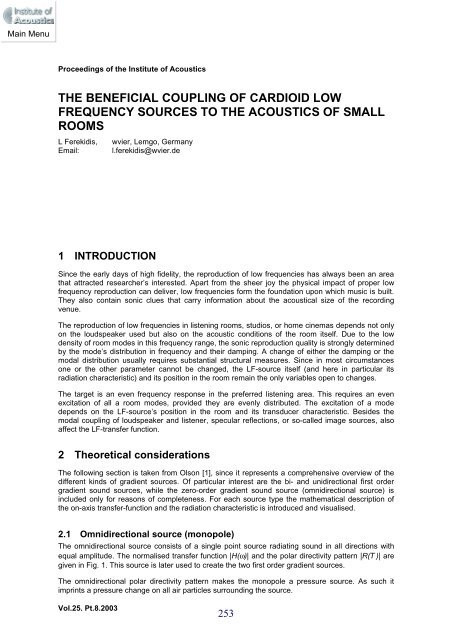
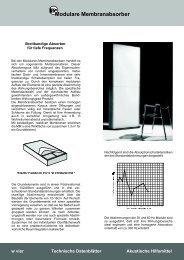

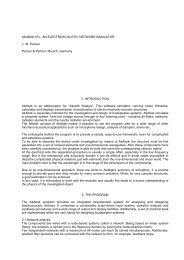
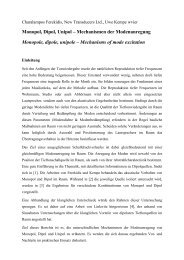
![Uwe KEMPE / Charalampos FEREKIDIS [w vier] Praktische ...](https://img.yumpu.com/16428023/1/184x260/uwe-kempe-charalampos-ferekidis-w-vier-praktische-.jpg?quality=85)
